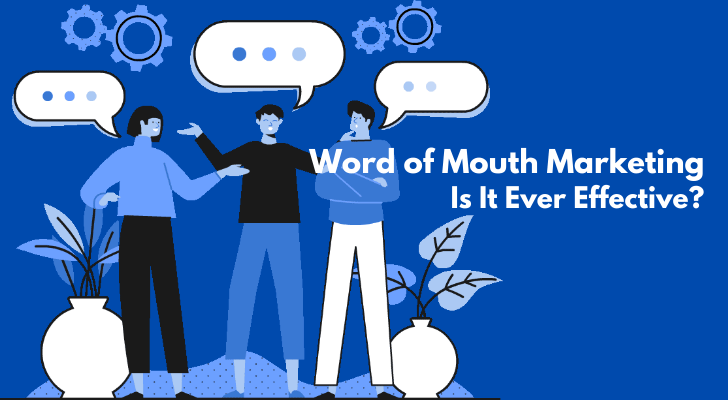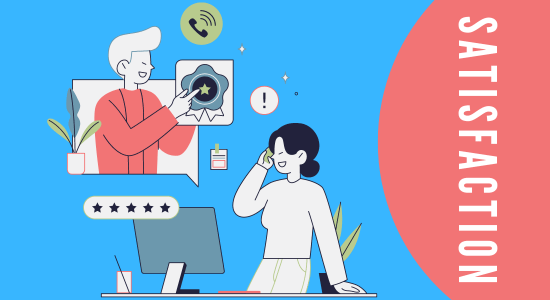Word-of-mouth marketing is a powerful strategy that has been around for centuries. Understandably, instead of relying on advertising and other forms of paid media, it relies on users to spread the word about your brand through positive recommendations and referrals.
With the rise of social media and online review sites, WOMM has become an increasingly important part of many businesses marketing strategies. Because people's words can be stronger than your own marketing messages. Through positive user reviews and shareable content, you can build brand awareness, attract new customers, and strengthen customer loyalty. Everyone from small business owners to multinational corporations is trying to harness the power of word-of-mouth advertising. But does it really work?

What is Word of Mouth Marketing?
Word-of-mouth marketing (WOMM) is a type of advertising that relies on recommendations and referrals from satisfied customers. Essentially, it's all about creating buzz around your product or service through positive word-of-mouth communication.
The marketing method has become even more important in the digital age as consumers increasingly rely on the opinions of their peers and online reviews to make purchasing decisions.
Understandably, many studies have shown that word of mouth is one of the most trusted forms of advertising. It’s been said that user recommendation is the primary factor behind up to 50% of all purchasing decisions, across any niche.
Did You Know?
- 92% of consumers trust recommendations from friends and family over any form of advertising.
- 74% of consumers identify word of mouth as a key influencer in their purchasing decision.
- Word of mouth has been shown to improve marketing effectiveness by up to 54%.
- 88% of people trust online reviews written by other consumers as much as they trust recommendations from personal contacts.
- 20 to 50% of all purchasing decisions are influenced by word-of-mouth.
- Customers acquired through WOMM spend 200% more than the average customer and make up to 2 times as many referrals.
- 83% of consumers are willing to refer after a positive experience—yet only 29% actually do.
A study by the American Marketing Association found that customers acquired through word of mouth have a higher lifetime value and are more loyal than those acquired through other channels.
You may agree that, with the rise of social media and online review sites, word of mouth can spread quickly and reach a large audience. Companies can leverage this by actively engaging with their customers and encouraging them to share their experiences and recommendations online.
Overall, word-of-mouth marketing is still a highly effective strategy for building brand awareness, attracting new customers, and strengthening customer loyalty in today's digital age.
CyberCash Wonderland
"Darling, have you heard about Brenda? She's closing down her shop because she's pregnant."
"What? But Brenda's single, isn't she? Who's the father?"
"Nobody knows! I've always thought she was a bit of a tart."
"I bet it's Jack the delivery man, I saw them messing around the other day..."
"Oh I love word-of-mouth marketing, such fun, isn't it?"
"Honey, this is not marketing, we're just gossiping..."
Supercharge Your AWeber Account
Take Your Email Marketing To The Next Level With These Powerful Tools
Types of WOMM
There are various types of Word of Mouth Marketing (WOMM) strategies that businesses can use to promote their brand.
WOMM refers to the spread of information about a product, service, or brand through conversations and recommendations among consumers. There are several types indeed, including:
Organic WOMM:
This type of WOMM occurs naturally when satisfied customers share their positive experiences with others. It can be generated by providing exceptional customer service, offering high-quality products, or creating a memorable customer experience.
Amplified WOMM:
Amplified WOMM is generated by companies through social media campaigns, influencer marketing, and other promotional tactics designed to encourage customers to share their experiences and opinions about a product or service.
Employer WOMM:
This type of WOMM occurs when current or former employees share their positive experiences working for a company with others. It can be generated by creating a positive work environment, providing good benefits and opportunities for growth, and fostering a culture of collaboration and innovation.
Customer-to-Customer WOMM:
Customer-to-customer WOMM occurs when customers recommend products or services to other customers. This can be facilitated through online review sites, social media groups, and other online communities where customers can share their experiences and recommendations.
Community WOMM:
Community WOMM involves building relationships with local communities, such as sponsoring local events or supporting charitable organizations. This can generate positive word of mouth by demonstrating a company's commitment to its community and its values.
As you can see, WOMM is a powerful method to help business owners build brand awareness, attract new customers, and strengthen customer loyalty.
Did You Know?
- 64% of marketing executives believe that word of mouth is the most effective form of marketing.
- 59% of consumers like to tell others about new products.
- 50% of all purchasing decisions are influenced by word-of-mouth.
- A Nielsen study found that 92% of consumers believe suggestions from friends and family more than advertising.
- Business to business (B2B) companies with referrals have a 70% higher conversion rate and report a 69% faster close time on sales.
- Brands that are highly talked about have growth rates up to 2x higher than brands that aren't.
- Offline word of mouth impressions drive at least 5 times more sales than paid advertising impressions, and much more (as much as 100 times for high-consideration categories).
"Is Your Business Suitable For WOMM?" Test
Q1. How would you describe your product/service quality?
- A) It's okay, gets the job done.
- B) Good, but similar to competitors.
- C) Excellent, often exceeds customer expectations.
Q2. Do you actively engage with your customers on social media?
- A) Rarely or not at all.
- B) Occasionally, when we remember to post.
- C) Regularly, with both posts and direct engagement.
Q3. How likely are your customers to recommend your product/service to others?
- A) Not very likely.
- B) Somewhat likely.
- C) Very likely, they often do without prompting.
Q4. Does your business have a unique story or brand identity?
- A) Not really, we're pretty standard.
- B) Somewhat, but it could be stronger.
- C) Yes, our story and identity are distinct and memorable.
Q5. How does your business handle customer feedback?
- A) We take note, but don't act on it much.
- B) We listen and sometimes make changes.
- C) We actively seek it out and often use it to improve.
Q6. Are you willing to invest in building a community around your brand?
- A) Not interested.
- B) Maybe, if it's not too much work.
- C) Absolutely, we believe in the power of community.
Q7. How often do new customers discover your business through existing customers?
- A) Rarely.
- B) Sometimes.
- C) Often, it's a significant source of new business.
Q8. Do you offer incentives for referrals?
- A) No, we haven't considered it.
- B) We have in the past, but it's not consistent.
- C) Yes, we have a structured referral program.
Q9. How would you describe your customer service?
- A) Basic – we meet the standard expectations.
- B) Good – we try to go above and beyond when we can.
- C) Exceptional – customer service is a top priority for us.
Q10. Does your product/service provide a unique solution to a problem?
- A) It's a common solution, not much different from others.
- B) It has some unique features, but it's not groundbreaking.
- C) Yes, it's innovative and different from anything else on the market.
Answers and My Advice
A1. Product/Service Quality
- A/B: While quality is crucial for WOMM, focusing on improving your product or service can make it more remarkable and shareworthy. Consider targeted advertising or SEO to build awareness as you work on enhancements.
- C: High quality is a strong foundation for WOMM. Happy customers are more likely to share their positive experiences with others.
A2. Engagement on Social Media
- A/B: Increasing engagement on social media can help ignite conversations about your brand. Start by creating engaging content and interacting more with your followers. Paid social media ads can also increase visibility while you build your organic presence.
- C: Regular engagement is perfect for WOMM. It fosters a sense of community and loyalty, encouraging customers to talk about your brand.
A3. Likelihood of Recommendations
- A/B: To boost recommendations, focus on improving customer satisfaction and consider loyalty programs. Targeted marketing and customer relationship management (CRM) strategies can also help grow your customer base.
- C: A high likelihood of recommendations suggests WOMM will be effective. Encourage this behavior with referral incentives.
A4. Unique Story or Brand Identity
- A/B: Developing a stronger, unique brand identity can enhance WOMM. Content marketing can help tell your story, while branding campaigns can differentiate your business.
- C: A unique story or identity naturally encourages WOMM as people love to share compelling stories about brands they feel connected to.
A5. Handling Customer Feedback
- A/B: Actively using customer feedback to improve can turn neutral or unhappy customers into promoters. Until then, focus on satisfaction surveys and direct outreach to understand your customers better.
- C: Using feedback to improve demonstrates you value your customers, fostering positive WOMM. It shows you're committed to excellence.
A6. Investing in Community Building
- A/B: Building a community is vital for WOMM but requires commitment. Consider content or email marketing to gradually build your community.
- C: A strong community significantly boosts WOMM by creating a loyal customer base that's engaged and willing to share their positive experiences.
A7. New Customers from Existing Ones
- A/B: If referrals are low, a structured referral program can help. Until it picks up, paid advertising and SEO can help attract new customers.
- C: High referral rates indicate WOMM is working well for you. Continue to incentivize and thank those who refer new customers to enhance this effect.
A8. Incentives for Referrals
- A/B: Introducing a referral program can stimulate WOMM. In the meantime, explore performance marketing to acquire new leads.
- C: An active referral program is excellent for WOMM, encouraging existing customers to spread the word and bring in new customers.
A9. Customer Service
- A/B: Elevating your customer service can transform customers into brand advocates. Consider using targeted ads to maintain visibility as you work on this.
- C: Exceptional customer service naturally leads to positive WOMM, as delighted customers often share their experiences with others.
A10. Unique Solution to a Problem
- A/B: Focus on innovation and differentiation. Meanwhile, niche marketing can help you reach specific segments more likely to appreciate your current offerings.
- C: Offering a unique solution positions you well for WOMM, as people are more likely to talk about and recommend innovative products or services.
How You Can Use The Marketing Method
Marketing in general, is all about a strategic approach that focuses on building strong relationships with customers and WOMM is no exception. But WOMM particularly encourages customers/users to share their positive experiences with others.

Provide exceptional customer experiences:
The foundation of WOMM is providing excellent customer experiences that customers will want to share with others. This includes offering high-quality products or services, providing exceptional customer service, and creating memorable experiences that customers will want to talk about.
Build relationships with customers:
Building strong relationships with customers is key to encouraging positive word of mouth. This includes engaging with customers on social media, responding to their feedback and concerns, and providing personalized experiences that show customers that you value their business.
Encourage customer reviews:
Encouraging customers to leave reviews on sites like Yelp, Google, and TripAdvisor can help build positive word of mouth and improve your online reputation.
Make it easy for customers to leave reviews by including links on your website and social media pages, and respond promptly to any negative feedback to show that you value customer input.
Create shareable content:
Creating content that customers will want to share with others can help spread positive word of mouth. This could include videos, infographics, blog posts, or social media content that highlights your brand's values, showcases your products or services, or tells a compelling story.
Leverage influencers:
Partnering with influencers or brand ambassadors who have a strong following can help amplify positive word of mouth about your brand. Make sure to choose influencers who align with your brand's values and have a genuine connection with their audience.
Consistently delivering high-quality products or services that exceed expectations is crucial for building a loyal customer base who will naturally promote your brand through recommendations and referrals.
Did You Know?
- An increase in word of mouth (offline and online) drives sales 10 times more than a 10% increase in paid media.
- 77% of consumers are more likely to buy a new product when learning about it from friends or family.
- 43% of consumers are more likely to buy a new product when they learn about it on social media.
- Consumers rely on word of mouth 2 to 10 times more than paid media.
- In the US, word of mouth leads to $6 trillion of annual consumer spending.
- Word of mouth can generate more than twice the sales of paid advertising in some categories.
The Pros and Cons of Word of Mouth Marketing
Although this type of marketing can create a sense of credibility and trust for users, there are disadvantages too. Here are the pros and cons:
Pros:
- High level of trust: Word of mouth is one of the most trusted forms of advertising, as people are more likely to believe recommendations from friends and family than ads or other forms of marketing.
- Cost-effective: WOMM can be a cost-effective marketing strategy, as it relies on customers to spread the word about your brand rather than expensive advertising campaigns.
- Builds brand credibility: Positive word of mouth can help build credibility and establish your brand as a trusted and reputable business.
- Generates customer loyalty: Customers who have positive experiences with your brand are more likely to become loyal advocates who recommend your business to others.
- Expands reach: Word of mouth can reach a large audience quickly, particularly through social media and online review sites.
Cons:
- Lack of control: Unlike traditional advertising, companies have little control over what is being said about their brand through word of mouth.
- Slow to build: It can take time to build a strong word-of-mouth campaign, as it relies on customers to spread the word.
- Negative word of mouth: Negative word of mouth can spread just as quickly as positive word of mouth, and can have a detrimental impact on your brand's reputation.
- Difficult to measure: It can be difficult to measure the impact of word of mouth on your business, as it is often difficult to track where recommendations are coming from.
- Limited reach: While word of mouth can reach a large audience quickly, it may not reach as many people as traditional advertising campaigns.
While Word of Mouth Marketing offers many benefits for businesses looking to increase their reach and build trust with consumers at low cost – it requires proper management because negative feedback spreads fast too!
What's The Difference Between Affiliate Marketing and Word-of-Mouth Marketing?

WOMM and affiliate marketing are two distinct marketing strategies, although they share some similarities.
WOMM occurs naturally when satisfied customers talk about their experiences with friends, family, or colleagues. So it focuses on cultivating positive word of mouth through exceptional customer experiences, engaging with customers, and encouraging them to share their opinions and recommendations.
On the other hand, affiliate marketing is a strategy where referrers - affiliates make money by promoting products.
The key difference between the two lies in the level of control and intent. WOMM occurs organically through customer advocacy and does not involve direct financial incentives or formal partnerships. In contrast, affiliate marketing involves a contractual agreement between a company and affiliates who are motivated by financial incentives to actively promote products or services.
Needless to say, both are effective strategies for driving business growth, but they operate in different ways and target different aspects of customer engagement and promotion. WOMM relies on the genuine enthusiasm of satisfied customers, while affiliate marketing relies on a network of affiliates who have a vested interest in promoting the products.
Case Studies of Successful and Unsuccessful Word-of-Mouth Marketing Campaigns
Successful Word of Mouth Marketing campaigns are those that have managed to create a buzz around the brand, products or services. One example is the "Ice Bucket Challenge" by ALS Association. The campaign was initiated to raise awareness about Amyotrophic Lateral Sclerosis (ALS) and went viral on social media platforms with people challenging their friends to dump ice buckets over their heads and donate money for the cause.
On the other hand, there have been instances where Word of Mouth Marketing has backfired for brands. A famous example is Nestle's "Give Your Baby Formula a Try" campaign in Africa, which encouraged mothers to switch from breastfeeding to using formula milk. This led to a decline in breastfeeding rates and an increase in infant mortality rates due to lack of access or affordability.
Another successful WOMM campaign was run by Dropbox when they offered extra storage space as an incentive for referrals. This not only increased customer loyalty but also brought new customers through word-of-mouth recommendations.
However, sometimes even well-intentioned campaigns can go wrong like McDonald's hashtag #McDstories aimed at creating positive stories about their food but ended up being hijacked by negative tweets from unhappy customers.
WOMM campaigns can be extremely effective if executed carefully while keeping in mind potential risks and consequences that may arise from poorly planned strategies.
Word of Mouth Marketing (WOMM): Is It Ever Effective? Wrapping Up
You know by now that Word-of-mouth marketing is a highly effective marketing strategy that relies on customers to spread the word about your brand through positive recommendations and referrals. It is a trusted form of advertising that can help build brand credibility, generate customer loyalty, and expand your reach.
However, WOMM does have its limitations. Companies have little control over what is being said about their brand through word of mouth, and negative word of mouth can have a detrimental impact on brand reputation. Additionally, measuring the impact of WOMM can be difficult, and it may not reach as many people as traditional advertising campaigns.
Despite these challenges, WOMM remains a powerful marketing strategy that can be particularly effective in the digital age, where consumers increasingly rely on the opinions of their peers and online reviews to make purchasing decisions. By focusing on providing exceptional customer experiences, building strong relationships with customers, and encouraging positive word of mouth through customer reviews and shareable content, businesses can leverage the power of WOMM to build brand awareness, attract new customers, and strengthen customer loyalty.
How I "Finally" Make Over $7,000 Monthly Income
"The most valuable thing I've ever done!"


